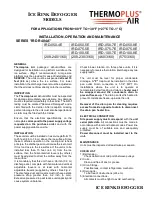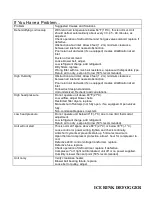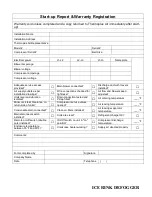
MAN-IRD-012-05-E
2
6) Air filters -
Must be replaced at least every two months.
NOTES:
1.
Warranty will be void if units operate under low
airflow conditions due to blocked filters.
2
. Unit must not be operated without filters.
REFRIGERANT CHARGE
These units are not standard packaged air
conditioners. They are specially engineered
refrigeration products.
Only qualified service
personnel should start and service these
machines. They can operate as low as 70 psig
(483 kPa) head pressure. The refrigerant charge of
R404A is marked on the nameplate. Do not exceed
the refrigerant charge marked thereon.
DEFROST SYSTEM
Field adjustment is provided for a selective defrosting
frequency at 30 - 45 - 90 minute intervals. Also the
defrost temperature termination is adjustable
from
55°F to 70°F (13°C to 21°C)
. In effect, the defrost
system is engineered to work on a
time initiated -
temperature terminated principle
with a frequency
and termination adjustment range, if required.
Initiation of the defrost cycle can only occur if the
suction temperature is below the fixed initiation
temperature of 26°F (-3°C) for more then the defrost
timer setting (30-45-90 min.). If the suction
temperature is above 26°F (-3°C) during the first sixty
seconds then the cycle is skipped. If the suction
temperature is 26°F (-3°C) or lower at any time during
the first sixty seconds, then the defrost cycle will
occur, timer will start counting at the end of the defrost
timer setting (30-45-90 min.) the defrost cycle will be
initiate.
The defrost will end when the suction temperature
reaches 55°F (13°C) or higher depending on the field
adjustments made afterwards. If the suction cannot
reach the desired preset temperature due to excess
ice or malfunction, a time safe termination will occur
after 10 minutes.
POSSIBLE MALFUNCTION
1)
Low refrigerant charge
2)
High refrigerant charge
3)
Defective hot gas valve
4)
Defective de-ice control
Refer to piping diagram for gas flow. (
Fig. 5
)
The installation of one or even two IRD Series units
may not be sufficient to eliminate stagnation,
especially when the ceiling structure creates
obstacles for good air distribution. A minimum of
two IRD Series units MUST be used in ice rink
applications.
IMPORTANT!!!
It is of utmost importance that NO air is blown
directly onto the ice surface since this causes
the ice to melt. The units must be equipped with
a 36 inch (0.9 m) discharge duct extension
complete with adjustable horizontal and vertical
louvers in the discharge grill.
Units must be installed as shown in the drawing
on the following page paying particular
attention to the mounting height above the ice
surface, and allowing a minimum of four feet
between the inlet and any obstacles such as an
end wall. This configuration is necessary in
order to "scoop" out the moist air from the ice
surface, without causing the ice to melt.
IMPORTANT!!!
Provide service access to the unit for maintenance,
inspection and service of components. Minimum
access area on all sides is 24 inches (0.6 m). A step
ladder is not considered a safe means of access.
Provide clearances according to the local building
and electrical codes.
Step 1
Pre-installation Inspection
Remove packing material and inspect for internal
and external shipping damage.
In case of transport damage, notify the carrier as
per instructions posted on the shipping crate.
Step 2
Location of the IRD Series Units
(See also drawing fig 1 and 3)
Provide service access to the unit for maintenance,
inspection and service of components. Filters must
be changed, the belt tension adjusted and the drain
pan may require periodic cleaning. A step ladder is
not considered a means of service access.
Minimum service access clearance on all sides is
two feet.
DO NOT install the unit over the ice surface, as
servicing will be dangerous.
Units must be level to ensure proper draining of the
condensate.



























